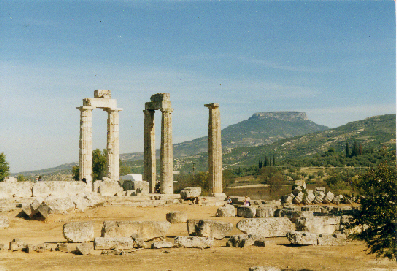On the Solstice came the happy news that the temple of Zeus at Nemea is finally without its scaffolding again! Together with the temple of Apollon in ancient Corinth, the temple of Zeus is the most emblemetic of the ancient monuments in the provence of Corinthia.
For those of you unfamiliar with the temple of Zeus at Namea, let me quote the article:
"Built c. 330 BC over the remains of an earlier temple, the Temple of Zeus lies in the center of the Sanctuary of Zeus at Nemea. The 9,240 square foot Temple played a significant role in the Nemea Games, one of the original Pan-Hellenic Games of Ancient Greece. It was before this Temple that, prior to the Nemea Games, the athletes would pay homage to the father of their gods, Zeus. The Temple’s construction included three Greek architectural forms, the Doric, the Corinthian, and the Ionic. 32 limestone columns each standing 42 feet tall, and composed of 13 cylindrical stones, called “drums”, each weighing approximately, 2.5 tons, surrounded the Temple of Zeus."
 While much of the old stone from the temple was preserved in the interior of a Basilica, all that remained upright of the temple were three limestone columns. Two more columns were reconstructed in 2002, including their crowning epistylia.
While much of the old stone from the temple was preserved in the interior of a Basilica, all that remained upright of the temple were three limestone columns. Two more columns were reconstructed in 2002, including their crowning epistylia.Dr. Konstantinos Papantonopoulos took on the next phase of the project, which was to reconstruct four more columns along the row. The project started in 2007, and now comes to a close with four beautifully reconstructed columns lining the outside of the temple. Between 2004 and 2012, a little over 2.5 million euro was pumped into the project, and while there are plans to reconstruct five more columns along the northern side of the temple, as the ancient material is preserved and a relevant study has already been conducted by architect Katerina Sklere, the current economic crisis in Greece has put these plans on hold.
 While much of the temple's building materials were recovered, the temple will never be fully reconstructed. The interior Corinthian columns are mostly missing. Thirty-two orthostates (squared stone blocks much greater in height than depth that are usually built into the lower portion of a wall) from the base of the interior wall, and 1,120 blocks from the upper part of the wall are missing as well. The exterior collonnade remains roughly complete, so these are viable for reconstruction, but to attempt more would mean adding so much modern day building materials that the building becomes, not a reconstruction, but a new building founded on an ancient foundation.
While much of the temple's building materials were recovered, the temple will never be fully reconstructed. The interior Corinthian columns are mostly missing. Thirty-two orthostates (squared stone blocks much greater in height than depth that are usually built into the lower portion of a wall) from the base of the interior wall, and 1,120 blocks from the upper part of the wall are missing as well. The exterior collonnade remains roughly complete, so these are viable for reconstruction, but to attempt more would mean adding so much modern day building materials that the building becomes, not a reconstruction, but a new building founded on an ancient foundation. My question to you, then, is the following: if you had the financial and legal means to do so, would you reconstruct the temple further? And if so, would you reconstruct it beyond the point where the ancient stones allow you to? Would you introduce modern day building materials if it meant a fully constructed Temple would be at your disposal? Something to ponder on a fine sunday.
My question to you, then, is the following: if you had the financial and legal means to do so, would you reconstruct the temple further? And if so, would you reconstruct it beyond the point where the ancient stones allow you to? Would you introduce modern day building materials if it meant a fully constructed Temple would be at your disposal? Something to ponder on a fine sunday.Fig 1. Plan view of the temple. The three columns standing from the ancient times are shown with orange. K-26 and K-27 were reconstructed in 2002. Taken from here.
Fig 2. 1805 drawing of the temple. Taken from here.
Fig 3. Image of the temple after reconstruction of two of the columns were completed in 2002. Taken from here.
Fig 4. An image of the temple as it stands today, taken from the article, copyright to Vima.
Fig 5. Aerial view of the Temple of Nemean Zeus in 1977. Taken from here.



No comments:
Post a Comment